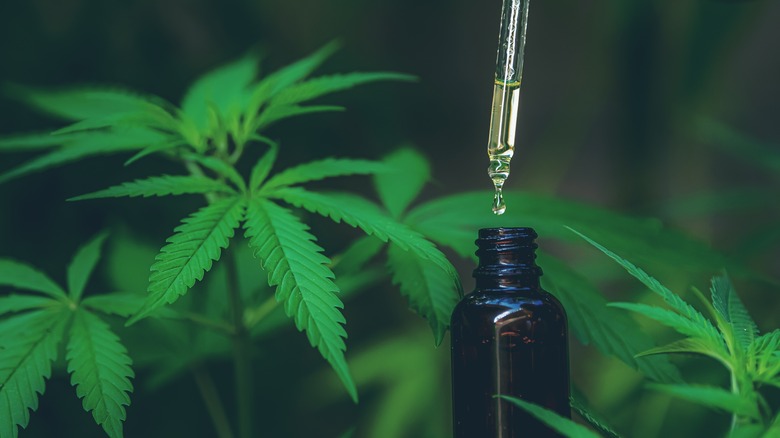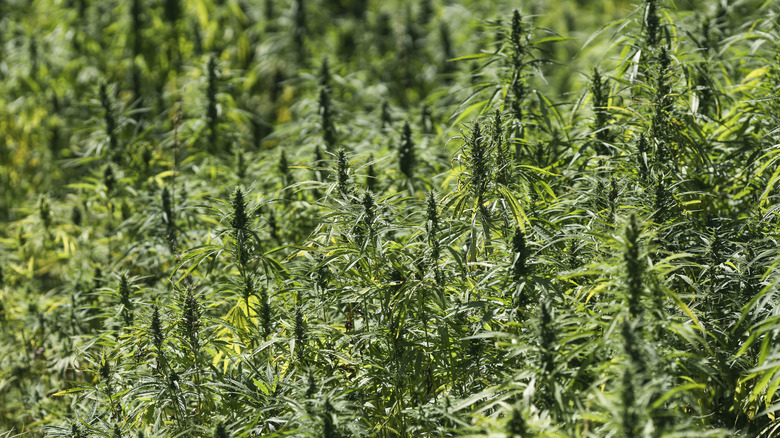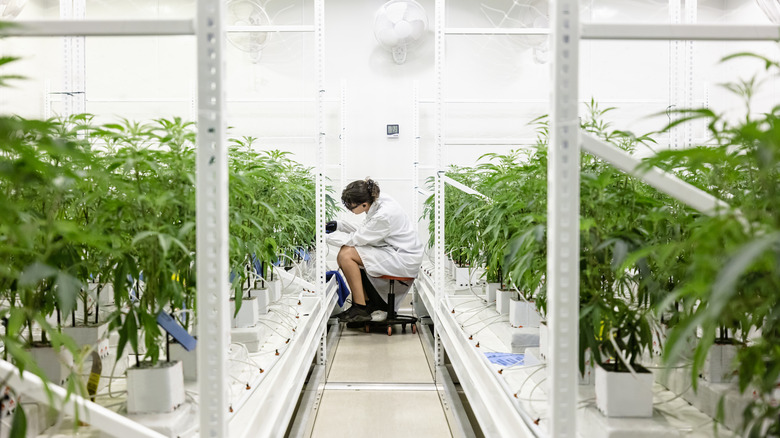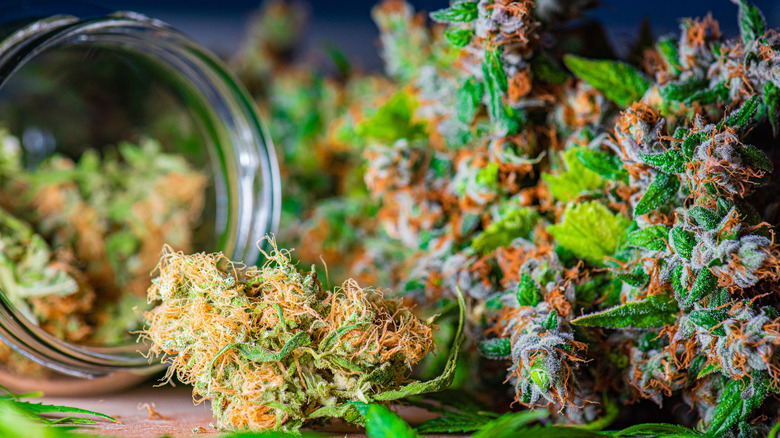What's The Difference Between Hemp And Marijuana?
Hemp: That stuff that vegan milk and hippie backpacks are made from. Marijuana: That stuff you eat or smoke that gets you high. Simple, right? But you might have heard along the way that hemp and marijuana are the same thing, or at least related to each other. So does that mean you could burn your hemp backpack and get hella stoned on its fumes? Could you drink like 10 liters of hemp milk at one time and get super wasted, or at least chill enough to stop telling people what an awesome alternative to cow milk it is? Some may be sad to hear that the answer to both questions is "no." But yes, hemp and pot are the same thing — kind of.
Hemp and marijuana both come from the exact same cannabis plant: That leafy green herb that made Mike Tyson calm way the heck down. The only difference between the two of them is the tetrahydrocannabinol (THC) content, as Healthline explains. If the dried cannabis in question has a THC content of 0.3% or less, it's hemp, and it can go in your organic smoothie. If the THC content is higher than 0.3%, it's marijuana, and it can be packed into blunts and puffed. Why 0.3%, you ask? It's just a convention, one established in the 1979 book "The Species Problem in Cannabis" by Ernest Small. So could you smoke dried cannabis with a THC percentage of 0.3% that would otherwise become a hemp product? Your call.
Hemp was selectively bred over the years
As the Drug Enforcement Administration (DEA) Museum explains, cannabis has been consumed going back to that most blazed of Chinese emperors, Shen Nung, circa 2727 B.C.E. The cannabis plant grew wild long before it was collected and domesticated, and the marijuana seed bank MSNL says it still grows wild in places like Nepal, Mexico, and Jamaica. If left untouched, this cannabis grows into its "largest and most potent" version, especially if harvested in autumn. Even still, such feral weed typically contains negligible amounts of THC.
Per Live Science, domesticated pot migrated out from mid-Asia over the centuries. Cannabis reached eastern Europe by 2,000 B.C.E., northern Africa by 700 C.E., southern Africa by 1400 C.E, and finally North America only in the 20th century. All in all, that's plenty of time for farmers to figure out how to cultivate different strains. It's no surprise then that the DEA says the United States is home to the "most powerful strains" of Cannabis sativa.
In the U.S., hemp grows naturally in places like Nebraska, Minnesota, and Oklahoma. Notably, hemp doesn't contain tetrahydrocannabinolic acid (THCA), the compound that produces the psychoactive THC that makes people high. The University of Saskatchewan reported in 2011 that a "simple genetic switch" turns off THCA production, via the American Association for the Advancement of Science (AAAS). "Essentially, this means that over thousands of years of cultivation, hemp farmers selectively bred Cannabis sativa into two distinct strains — one for fibre and seed, and one for medicine," the non-profit organization wrote.
Unlike marijuana, hemp is made exclusively from cannabis sativa
As noted by Britannica and WebMD, hemp comes from Cannabis sativa plants — not Cannabis indica or Cannabis ruderalis. CBD (cannabidiol) makers Alpinols go into some detail about the differences between sativa, indica, and ruderalis. In short, sativa grows tall, quickly, and with long leaves, and when consumed it has a stimulating yet relaxing effect. It also typically has more THC than CBD (the former is psychoactive, the latter is not). Meanwhile, indica is short, shrub-like, and usually has less THC than CBD. Finally, ruderalis doesn't branch and has narrow leaves, which produce a low yield. HERBLIZ says this species typically has high CBD levels and low THC levels.
Hemp itself is a wildly versatile product. We joked about hemp milk and hemp bags earlier in this article, and Alpinols extends the list to now-familiar hemp oil, hemp flour, and hemp seeds. In discussing this type of "industrial hemp" further, the United Nations Conference on Trade and Development (UNCTAD) even mentions products like hemp biofuel and building materials. This is why the article not only describes cannabis as miraculous in its applications but also discusses how it uses far less water to grow than crops like cotton, absorbs more carbon dioxide, is a renewable resource that practically takes care of itself, and is perfect for developing countries to boost their economies. Ultimately, whether you prefer your cannabis plant in doobie or shoe form, you can't go wrong with the results.
Very different legal statuses
When it comes to the law, the aforementioned 0.3% THC cut-off means that hemp and marijuana get treated very differently. 2018 was a key year for hemp in the United States, as Congress passed the 2018 Farm Bill to create a regulatory, national framework for growing hemp like any other industrial crop (at that point details fell to states). Vote Hemp has a full breakdown of hemp-growing laws per state, which differ but almost universally turned 180 from the mid- to late-2010s. And of course, hemp laws vary across the world. The European Commission, for instance, has records of hemp seed regulations for commercial use dating back to 2003.
Marijuana, as the reader can imagine, is a different story. DISA has a full, complex, headache-inducing map of legalization in the United States, covering all categories of legal statuses: legal, illegal, medical, decriminalized, medical and decriminalized, and CBD only. On the whole, though, folks not only in the U.S. but worldwide have grown more accepting of marijuana in recent decades. Even zero-tolerance countries like Japan have started considering legalizing medical marijuana use, as The Japan Times shows. And no matter who opposes the growth of the pot industry, Statista estimates that by 2028, the global, legal marijuana market will grow to nearly $103 billion. That's up from a mere $6.6 billion in 2016.



